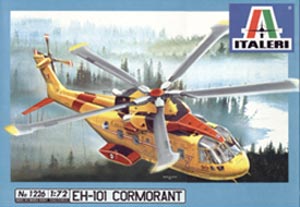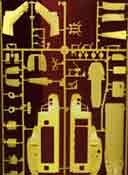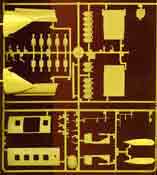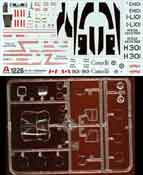| Italeri 1/72nd Cormorant |
| |
 |
|
| First off let me just say this: Cormorant?!? What's
wrong with Merlin, which is the british name for the EH-101? A Cormorant
is a rather unpleasant looking diving sea bird with a hooked beak if I'm
not mistaken. Well, okay, a Merlin is also a bird, a type of Falcon to
be precise, but it's a much cooler name in my opinion and in the Arthurian
context conjures up - no pun intended - much nicer images in my head. |
| This is the third release of these mouldings, the first being the Royal
Navy version from Italeri and the second the RAF HC3 via Revell of Germany.
Canada has purchased 15 CH-149s (the canadian designation for the EH-101)
with the first few in service in 2002 and the remainder in operation by
the end of 2003. The CH-149 will replace the long serving CH-113 Labrador
as Canada's main SAR helicopter and will operate from Gander Newfoundland,
Trenton Ontario, Comox B.C., and Greenwood Nova Scotia. |
| The Cormorant (hereafter referred to as the CH-149 because I really don't
like the name!) has three Rolls-Royce / Turbomeca RTM 322 turbines of
2,312 shp each, is 22.81m (74ft 10 in) long, 6.5m (21ft 4in) high with
a rotor span of 18.59m (61ft) and a maximum takeoff weight of 14,600kg
(32,120lb). Maximum speed is 309km/h (192mph). |
|
|
| Italeri's kit consists of three sprues of nicely moulded parts in a lovely
yellow plastic with a sprue of excellent clear parts (packed in a plastic
bag - thank you Italeri!). Fine recessed panel lines and delicate raised
rivets abound and there is adequate detail in both the cockpit and crew
areas in the form of bulkheads, floors, collective and cyclic controls,
and nice two part seats for the former and jump seats with moulded on
belts for the latter. The rear loading ramp looks to be moveable and,
although not mentioned in the instructions, I'm sure the main cabin doors
could be posed open to show off the detail there. There is no internal
structure moulded on the inside of the fuselage halves however. Decals
are included for the cockpit instrument panels and seatbelts. |
| Italeri has done a nice job of capturing the look of the relatively simple
rotor head and somewhat bizarrely shaped main rotor blades. |
Decal sheet includes markings for two aircraft, #901 and the
demonstrator I-L101 and it is the latter that I'm assuming Italeri have
based their kit on. Pictures on the Canadian
Air Force site of the first two CH-149s to enter Canada, numbers 904
and 905, reveal several omissions and anomalies on both the kit mouldings
and decal sheet which lead me to believe the kit is based on the demonstrator:
-
The forward cabin windows should be round domes like the rearmost
windows and not square as in the kit. I think vacforming copies of
the rear windows would be the easiest way around this.
-
There is a prominent searchlight located low on the port side beneath
the third window from the front that is not included. Shouldn't be
too hard to scratchbuild from some tubing, stretched sprue and an
MV Products lens.
-
What appears to be a chaff/flare dispenser is moulded on the starboard
fuselage side below the cabin door but is not present on either of
the CH-149s pictured on the CAF site.
- There is a "pie plate" shaped thingy slightly below and
behind the rear dome window on the starboard side that is not in the
kit. This is, if I'm not mistaken, a CPI (Crash Position Indicator)
and again, would not be difficult to scratchbuild.
-
Possibly the most difficult to correct is the shape of the sponson
sides. The kit parts have a large bulge that covers about two thirds
of the sponson sides whereas the real thing has only a small square
bulge on the forward part of the sponsons. Fortunately the plastic
is thick enough that the bulges could either be reduced in size or
sanded off completely and replaced with plastic card.
-
The antenna on the port side at the rear of the cabin area is quite
different from that provided by Italeri. Cut the mounts off of parts
14E and 17E and use them with new antennas made from wire. Piece o'
cake.
-
The "Canadian Forces/Forces Canadiennes" markings are missing
from the decal sheet as is the small canadian flag that should go
next to them. Note this flag has no white background, it's just red
on yellow. This also applies to the small flag over the 'a' of "Canada"
which Italeri has incorrectly printed with a white backing. Also missing
are the prominent dotted lines around the windows and doors which
show rescue crews where to cut in the event of an emergency. The decal
sheet is however, beautifully printed and does include all of the
black walkways on top of the fuselage as well as the red and white
tail rotor stripes and some stencilling.
|
| Italeri quote the length of the completed model as 31.6
cm including the rotor. As the dimensions I have from the CAF site are
for the fuselage and rotor seperately it will be difficult to assess the
scale dimensions without actually building the thing - something I hope
to do soon. Right after I finish the three hundred other projects I "hope
to do soon...". |
| Although the list of corrections and additions needed to correctly protray
an in service machine seems quite long, none of them are very difficult
and I believe an excellent model would still result straight from the
box. Especially if one wishes to do the demonstrator, although I haven't
found any pics of that so I'm only assuming the kit is based on it. |
| Highly recommended and at £10.99 it's a pretty good deal considering
the size of this thing. Still not happy with Canada's choice of name though.
Cormorant.... Pah!! ¦-( |




